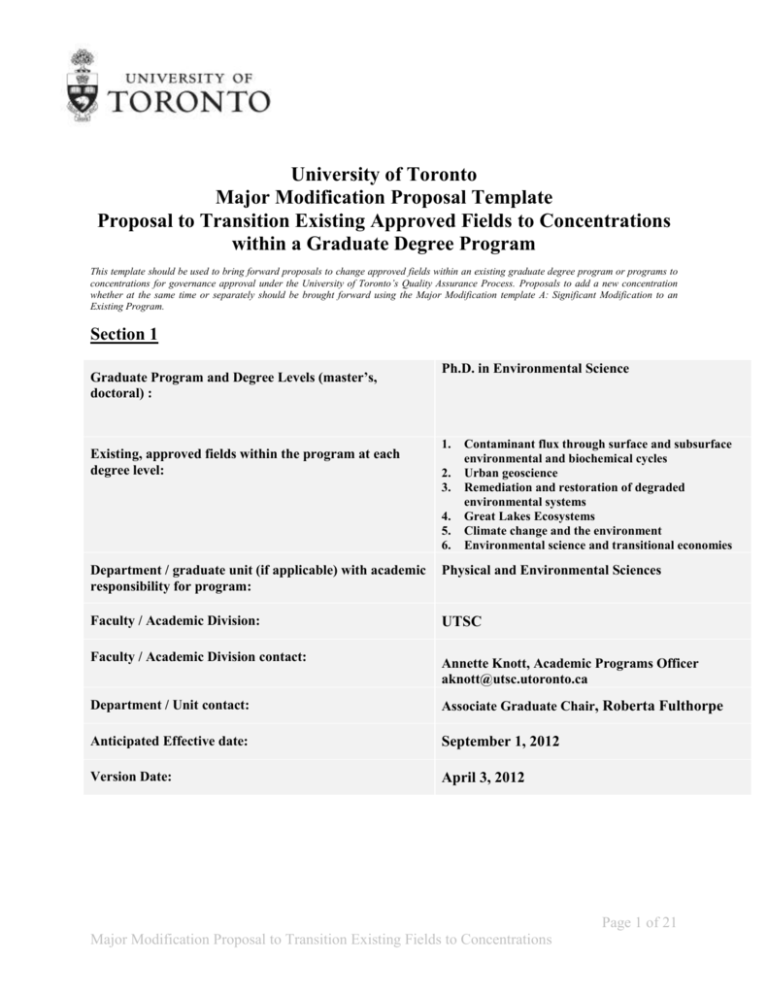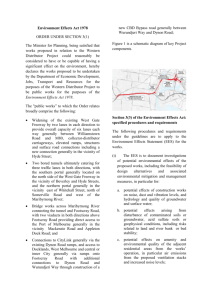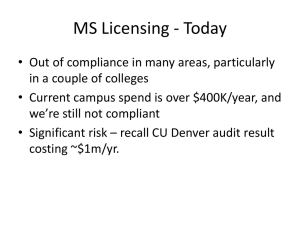This template should be used to bring forward proposals to change
advertisement

University of Toronto Major Modification Proposal Template Proposal to Transition Existing Approved Fields to Concentrations within a Graduate Degree Program This template should be used to bring forward proposals to change approved fields within an existing graduate degree program or programs to concentrations for governance approval under the University of Toronto’s Quality Assurance Process. Proposals to add a new concentration whether at the same time or separately should be brought forward using the Major Modification template A: Significant Modification to an Existing Program. Section 1 Graduate Program and Degree Levels (master’s, doctoral) : Existing, approved fields within the program at each degree level: Ph.D. in Environmental Science 1. 2. 3. 4. 5. 6. Contaminant flux through surface and subsurface environmental and biochemical cycles Urban geoscience Remediation and restoration of degraded environmental systems Great Lakes Ecosystems Climate change and the environment Environmental science and transitional economies Department / graduate unit (if applicable) with academic responsibility for program: Physical and Environmental Sciences Faculty / Academic Division: UTSC Faculty / Academic Division contact: Annette Knott, Academic Programs Officer aknott@utsc.utoronto.ca Department / Unit contact: Associate Graduate Chair, Roberta Fulthorpe Anticipated Effective date: September 1, 2012 Version Date: April 3, 2012 Page 1 of 21 Major Modification Proposal to Transition Existing Fields to Concentrations Section 2 1. Executive Summary This is a proposal to transition the existing, approved fields within the PhD degree program in Environmental Science to concentrations. These fields were most recently approved by OCGS in June 2010. This major modification to the existing degree program will be effective September 1, 2012. The PhD program in Environmental Science has 6 fields as below: 1.Contaminant flux through surface and subsurface environmental and biochemical cycles 2. Urban geoscience 3. Remediation and restoration of degraded environmental systems 4. Great Lakes Ecosystems 5. Climate change and the environment 6. Environmental science and transitional economies. These fields were originally approved by OCGS June 18, 2010. Under this proposal these approved fields would all become concentrations and would henceforth be noted on students’ transcripts as such. 2. Academic Rationale Traditionally, any graduate program seeking to advertise or make known a distinctive area of strength or specialization within their program was required (by the Ontario Council of Graduate Studies) to secure formal approval for a graduate field. Fields were expected to reflect the “broad foci of the program” and to be “congruent with the broad expertise of the core faculty members.” The identification of fields within a graduate program was “meant to give specificity to a program compared to other similar programs in Ontario.” Fields were not required within Master’s programs but were required within all PhD programs. The process of approval for a new field was rigorous and required OCGS approval. Fields were recorded on a student’s transcript. With the transition from OCGS to the Ontario Universities Council on Quality Assurance (Quality Council) fields continue to be a feature of graduate programs, where desirable. They are defined by the Quality Assurance Framework as “an area of specialization or concentration (in multi/interdisciplinary programs a clustered area of specialization) that is related to the demonstrable and collective strengths of the program’s faculty.” At the same time, the Quality Assurance Framework also recognizes “programs of specialization” or “concentrations” which it defines as “An identified set and sequence of courses, and/or other units of study, research and practice within an area of disciplinary or interdisciplinary study, which is completed in … fulfillment of the requirements for the awarding of a degree, and is recorded on the graduate's academic record.” Rooted in the Province’s Quality Assurance Framework, the University of Toronto has come to the following clarification of fields and concentrations and their characteristics. Page 2 of 21 Major Modification Proposal to Transition Existing Fields to Concentrations Definition Advertising: Admission: Requirements: Transcript: Approvals: Fields A field is an identified area of specialization in a graduate degree program that is related to demonstrable and collective strengths of the program’s faculty members. There is no requirement to identify fields in either master’s or doctoral programs. Initial proposals for fields require University governance approval and the endorsement of the Quality Council. As with all academic initiatives, proposals for fields require demonstration of adequate resources. Approved fields have the following characteristics: An approved field may be used to advertise an area of strength within a graduate program. In some programs, students may be admitted directly into an approved field within a program, though there is no requirement to do so. Students may be identified with a field in a program upon admission. The total number of courses and other program requirements in an individual field normally are the same as the overall degree program requirements, and the same as in any other field in the program. There usually is a common set of requirements for the degree program regardless of field. Approved fields may appear as notations on the student transcript upon completion of the degree program. A proposal for a field follows the Expedited New Program Process and requires University governance approval of the Division and Academic Policy and Programs Committee and requires Quality Council endorsement. Concentrations A concentration is associated with an identified area of study, often requiring completion of a specific set of courses, in a graduate degree program. Concentrations may be offered in place of fields. There is no requirement to identify concentrations in either master’s or doctoral programs. As with all academic initiatives, proposals for concentrations require demonstration of adequate resources. Approved concentrations have the following characteristics: A graduate program may advertise concentrations in association with the graduate program. In some programs, students may be admitted directly into an approved concentration within a program, though there is no requirement to do so. Students may be identified with a field in a program upon admission. The total number of courses and other program requirements in an individual concentration normally are the same as the overall degree program requirements, and the same as in any other concentration in the program. There usually is a common set of requirements for the degree program regardless of concentration. Approved concentrations may appear as notations on the student transcript upon completion of the degree program. A proposal for a concentration is a Major Modification and requires University governance approval at the level of the Division and is reported to Academic Policy and Programs Committee for information, and also is reported to Quality Council. In line with the University of Toronto’s understanding of fields and concentrations, the graduate degree program in Environmental Science has prepared this proposal to seek governance approval to transition its existing approved fields to concentrations. This proposal applies solely to the PhD program. Fields are rooted in and reflect distinct areas of expertise and scholarship of the program faculty. They tend to identify quite distinct areas of interest and research. In this sense, the creation of a new field commonly reflects a new and substantive direction for a program and is treated by the UTQAP as a subset of the new program category requiring expedited approval by the Quality Council. Fields by virtue of their definition, the investment of time and energy required for their approval, and also by the manner in which they are tied to the demonstrated expertise of the faculty complement, tend to possess a certain sense of stability and constancy. Fields commonly change slowly and infrequently. Often, the identification of fields conforms to established disciplinary norms and has a significance that goes beyond the purely curricular. In certain contexts fields will continue to be seen as appropriate, constructive, and informative. In contrast, concentrations, while equally rooted in the capacity of the research faculty to support graduate level research in specific areas, suggest a more flexible offering that can evolve in a timely manner and can be appropriately responsive to changes in the area of study. Concentrations by their very nature will reflect the evolving interests of faculty and prospective students but need not be as entirely distinct and free-standing as a field is expected to be. This latter construction is felt by the graduate degree program in Environmental Science to be more appropriate to the nature of their program, its goals and interests. Environmental Science is an emerging discipline that responds to contemporary environmental challenges. Thus flexibility Page 3 of 21 Major Modification Proposal to Transition Existing Fields to Concentrations in modifying concentrations appropriately is highly desirable to mirror the concurrent evolution in the discipline. For example the critical importance of climate change as emerged as a dominant if not the dominant theme in Environmental Science in the last five years whereas environmental degradation was the dominant theme prior to this. We anticipate that other themes will come to the fore that the discipline will eagerly tackled. This is in contrast to many other discipline with well defined canons of study and clear research trajectory. 3. Description of the Proposed Major Modification(s) 1. To transition the existing, approved fields within the PhD degree program in Environmental Science to concentrations. The Ph.D. in Environmental Science currently has 6 fields as follows: 1.Contaminant flux through surface and subsurface environmental and biochemical cycles 2. Urban geoscience 3. Remediation and restoration of degraded environmental systems 4. Great Lakes Ecosystems 5. Climate change and the environment 6. Environmental science and transitional economies. Program requirements will not change, there will be no changes to learning outcomes, and no changes to the faculty engaged in the delivering the program or to essential physical resources. The proposed transition of the existing fields within the Ph.D. in Environmental Science would be effective September, 2012. Under the University of Toronto Quality Assurance process (UTQAP) this change is considered a major modification to an existing program requiring Divisional Council approval. The approval of a major modification is reported as a major modification for information to the Academic Policy and Programs Committee of Governing Council and also to the Quality Council. 4. Requirements Please see Appendix A for full, revised calendar copy. 5. Impact of the Change on Students The following table shows enrolment in the PhD in Environmental Science by field. Students enrolled in the program will be “grand-parented” with respect to existing fields. Concentrations will be available to new students admitted as of the effective date of the change. Currently there are 5 students in their second year and ten students in their first year. One student who transferred in from another program is in her 4th year. Field Contaminant flux through surface and # of students 4 Page 4 of 21 Major Modification Proposal to Transition Existing Fields to Concentrations subsurface environmental and biochemical cycles Urban geoscience Remediation and restoration of degraded environmental systems Great Lakes Ecosystems Climate change and the environment Environmental science and transitional economies. 1 5 1 4 1 6. Consultation This proposal is the product of extensive discussion and consultation amongst the graduate faculty teaching in this program. The graduate program in Environmental Science has also worked closely with the UTSC Dean’s Office, the School of Graduate Studies, and the Office of the Vice-Provost, Academic Programs in bringing this proposal forward in order to ensure that it is conformity with academic institutional norms. The Dean’s Office in FAS and UTM have been consulted and have expressed their support for this change. 7. Resources: This proposal has no resource implications. 8. Governance Process: Levels of Approval Required Dean’s Office Sign Off Divisional Governance Submission to Provost’s Office AP&P – reported annually Ontario Quality Council reported annually Page 5 of 21 Major Modification Proposal to Transition Existing Fields to Concentrations Appendix A: provide the revised calendar copy. Revised calendar copy Original Requirements (as of March 15, 2012) with Proposed Changes Tracked: Physical and Environmental Sciences Faculty Affiliation University of Toronto Scarborough Degree Programs Offered Environmental Science – MEnvSc, PhD Fields (MEnvSc): Biophysical Interactions in Terrestrial and Aquatic Systems Concentrations (PhD): Contaminant Flux Through Surface and Subsurface Environmental and Biochemical Cycles Urban Geoscience Remediation and Restoration of Degraded Environmental Systems Great Lake Ecosystems Climate Change and the Environment Environmental Science and Transitional Economies Overview The Graduate Department of Physical and Environmental Sciences offers opportunities for graduate studies in Environmental Science, leading to the degrees of Master of Environmental Science (MEnvSc) and Doctor of Philosophy (PhD) in Environmental Science. Page 6 of 21 Major Modification Proposal to Transition Existing Fields to Concentrations Contact and Address Web: www.utsc.utoronto.ca/~physsci Email: dpes-mesc-program@utsc.utoronto.ca or dpes-phd-program@utsc.utoronto.ca Telephone: (416) 287-7357 Fax: (416) 287-7204 Department of Physical and Environmental Sciences University of Toronto Scarborough 1265 Military Trail Toronto, Ontario M1C 1A4 Canada Degree Programs Environmental Science Master of Environmental Science The department offers a 12-month coursework Master of Environmental Science (MEnvSc) degree program. Courses within the program fall within the designated field of study: Biophysical Interactions in Terrestrial and Aquatic Systems. Although the program base is broad, a major focus for training professionals is understanding the flux of contaminants through surface and sub-surface environments and the methods/solutions needed to remediate contaminated or damaged environmental systems. The program is committed to the development of well-trained practitioners in environmental science to meet the needs Page 7 of 21 Major Modification Proposal to Transition Existing Fields to Concentrations primarily of industry and government. The MEnvSc program offers three enrolment options: Research Internship Part-time studies Minimum Admission Requirements Students are expected to satisfy all requirements for entry into the School of Graduate Studies at the University of Toronto within a competitive selection process. Applicants educated outside Canada should pay particular attention to the English language competency requirements. An appropriate bachelor's degree from a recognized university, either in science or engineering, with a minimum mid-B grade average in the last two years of the undergraduate program. Ideal applicants will have a science background consisting of two half courses or one full course in each of chemistry, physics, calculus, and biology. Applicants must submit a written statement explaining their objectives for entering the program and the suitability of their background. Appropriate postgraduate work experience, such as in industry, will be considered as part of the admission application. Program Requirements In all enrolment options, coursework consists of 5.5 full-course equivalents (FCEs). It is anticipated that students will complete all instructional courses in two sessions and will complete field and research-focused courses as well as the internship during the summer. Normal Program Length: 3 sessions full-time Page 8 of 21 Major Modification Proposal to Transition Existing Fields to Concentrations Time Limit: 3 years full-time; 6 years part-time Course List EES 1100H Advanced Seminar in Environmental Science EES 1101Y Research Paper in Environmental Science EES 1102H Analytical Chemistry for Geoscientists EES 1103H Air and Water Quality Sampling and Monitoring EES 1104H Microorganisms and the Environment EES 1105H Soil Contamination Chemistry EES 1106H Environmental Challenges in Urban Areas EES 1107H Remediation Methods EES 1108H Environmental Science Field Camp EES 1109H Advanced Techniques in Geographic Information Systems EES 1110H Sediment and Contaminant Transport in Aquatic Systems EES 1111H Freshwater Ecology and Biomonitoring EES 1112H Boundary Layer Climates and Contaminant Fate EES 1113H Groundwater Hydrochemistry and Contaminant Transport EES 1114H Directed Readings in Environmental Science I EES 1115H Directed Readings in Environmental Science II EES 1116Y Internship EES 1117H Climate Change Impact Assessment EES 1118H Fundamentals of Ecological Modelling EES 1119H Quantitative Environmental Analysis EES 1120H The Dynamics of Contaminant Dispersal in Fluids Page 9 of 21 Major Modification Proposal to Transition Existing Fields to Concentrations EES 1121H Modelling the Fate of Organic Chemicals in the Environment EES 1122H Global Environmental Security and Sustainable Development EES 1123H Environmental Regulations EES 1124H Environmental Project Management EES 1125H Contaminated Site Remediation EES 1126H Environmental Tracers EES 1127H Geomicrobiology and Biogeochemistry EES 1128H Biophysical Interactions in Managed Environments EES 1129H Brownfields Redevelopment EES 1130H Ontario BioGeospheres Field Course EES 1701H Environmental Legislation and Policy EES 1704H Environmental Risk Assessment Doctor of Philosophy Research and teaching are focused on the interfaces between traditional disciplines in dealing with fundamental scientific issues. Faculty members are cross-appointed from several departments including physical sciences, biological sciences, engineering, forestry and social sciences. Minimum Admission Requirements Students may be accepted into the PhD program through one of three routes: 1. Following completion of the MEnvSc degree, an MSc degree in environmental science, or a related discipline, or the MASc degree in environmental engineering or related discipline, or equivalent from a recognized university with a minimum of B+ average in all work completed in the master’s program. Page 10 of 21 Major Modification Proposal to Transition Existing Fields to Concentrations 2. By requesting transfer from a suitable master’s program (see above); students may reclassify from the master’s program after 12 months of full-time study. 3. In the case of exceptional students, by direct entry, that is, after completing an honours BSc degree in a bachelor’s program in a related discipline with a minimum UofT average of A- or equivalent. Program Requirements The execution of an original piece of research in environmental science carried out under faculty supervision and presented in thesis form. The program requires successful defence of a thesis proposal, a departmental oral examination of the completed thesis, and a doctoral final oral examination carried out under the auspices of the School of Graduate Studies involving examination by an appropriate at-armslength examiner. A total of 2.0 full-course equivalents (FCEs) as follows: a mandatory 0.5 FCE (ENV 2200H Advanced Seminar on Environmental Research) plus 1.5 FCEs from an approved course list in the graduate program. The courses are required to provide background for the student’s research. Courses selected must be approved by the Graduate Coordinator/Program Director. Students may apply to take a number of PhD-level courses taught by the core faculty both within the Department of Physical and Environmental Sciences (DPES) and outside DPES that can be considered for the PhD degree (see examples in the Course List section below) as part of their 1.5 FCEs credits for the degree. However, all courses for PhD degree credit must be approved by the Graduate Coordinator/Program Director. At the time of the PhD Appraisal, if a student’s preparedness is assessed as being insufficient, the student will be required to take additional courses. The degree requirements consist of successful completion of coursework, a PhD oral exam appraisal, and a thesis. The degree program has been designed so that it can be completed within: Page 11 of 21 Major Modification Proposal to Transition Existing Fields to Concentrations o four years for students who have completed a related master’s degree. o five years from the start of enrolment in the MSc program for students transferring from the master’s program. o five years for direct-entry students from a bachelor’s program. Progress through the PhD program for students admitted with a master’s degree: o Year I: complete coursework o Year II: complete and defend thesis proposal; start thesis research o Year III: research and thesis writing o Year IV: thesis writing and defense Normal Program Length: 4 years full-time; 4 years direct-entry Time Limit: 6 years full-time; 7 years direct-entry Course List Core Course EES 2200H Advanced Seminar in Environmental Science The following are courses that are offered with the Department of Physical and Environmental Sciences. With the approval of the Associate Graduate Chair, relevant courses from other graduate departments can be applied to the required 1.5 FCEs. Elective Courses EES 1102H Analytical Chemistry for Geoscientists Page 12 of 21 Major Modification Proposal to Transition Existing Fields to Concentrations EES 1103H Air and Water Quality Sampling and Monitoring EES 1104H Microorganisms and the Environment EES 1105H Soil Contamination Chemistry EES 1106H Environmental Challenges in Urban Areas EES 1107H Remediation Methods EES 1109H Advanced Techniques in Geographic Information Systems EES 1110H Sediment and Contaminant Transport in Aquatic Systems EES 1111H Freshwater Ecology and Biomonitoring EES 1112H Boundary Layer Climates and Contaminant Fate EES 1113H Groundwater Hydrochemistry and Contaminant Transport EES 1117H Climate Change Impact Assessment EES 1118H Fundamentals of Ecological Modelling EES 1119H Quantitative Environmental Analysis EES 1120H The Dynamics of Contaminant Dispersal in Fluids EES 1121H Modeling the Fate of Organic Chemicals in the Environment EES 1122H Global Environmental Security and Sustainable Development EES 1126H Environmental Tracers EES 1127H Geomicrobiology and Biogeochemistry EES 1128H Biophysical Interactions in Managed Environments EES 2201H Advanced Readings in Environmental Science Page 13 of 21 Major Modification Proposal to Transition Existing Fields to Concentrations Calendar Entry with Proposed Changes Accepted: Physical and Environmental Sciences Faculty Affiliation University of Toronto Scarborough Degree Programs Offered Environmental Science – MEnvSc, PhD Fields (MEnvSc): Biophysical Interactions in Terrestrial and Aquatic Systems Concentrations (PhD): Contaminant Flux Through Surface and Subsurface Environmental and Biochemical Cycles Urban Geoscience Remediation and Restoration of Degraded Environmental Systems Great Lake Ecosystems Climate Change and the Environment Environmental Science and Transitional Economies Overview The Graduate Department of Physical and Environmental Sciences offers opportunities for graduate studies in Environmental Science, leading to the degrees of Master of Environmental Science (MEnvSc) and Doctor of Philosophy (PhD) in Environmental Science. Page 14 of 21 Major Modification Proposal to Transition Existing Fields to Concentrations Contact and Address Web: www.utsc.utoronto.ca/~physsci Email: dpes-mesc-program@utsc.utoronto.ca or dpes-phd-program@utsc.utoronto.ca Telephone: (416) 287-7357 Fax: (416) 287-7204 Department of Physical and Environmental Sciences University of Toronto Scarborough 1265 Military Trail Toronto, Ontario M1C 1A4 Canada Degree Programs Environmental Science Master of Environmental Science The department offers a 12-month coursework Master of Environmental Science (MEnvSc) degree program. Courses within the program fall within the designated field of study: Biophysical Interactions in Terrestrial and Aquatic Systems. Although the program base is broad, a major focus for training professionals is understanding the flux of contaminants through surface and sub-surface environments and the methods/solutions needed to remediate contaminated or damaged environmental systems. The program is committed to the development of well-trained practitioners in environmental science to meet the needs Page 15 of 21 Major Modification Proposal to Transition Existing Fields to Concentrations primarily of industry and government. The MEnvSc program offers three enrolment options: Research Internship Part-time studies Minimum Admission Requirements Students are expected to satisfy all requirements for entry into the School of Graduate Studies at the University of Toronto within a competitive selection process. Applicants educated outside Canada should pay particular attention to the English language competency requirements. An appropriate bachelor's degree from a recognized university, either in science or engineering, with a minimum mid-B grade average in the last two years of the undergraduate program. Ideal applicants will have a science background consisting of two half courses or one full course in each of chemistry, physics, calculus, and biology. Applicants must submit a written statement explaining their objectives for entering the program and the suitability of their background. Appropriate postgraduate work experience, such as in industry, will be considered as part of the admission application. Program Requirements In all enrolment options, coursework consists of 5.5 full-course equivalents (FCEs). It is anticipated that students will complete all instructional courses in two sessions and will complete field and research-focused courses as well as the internship during the summer. Normal Program Length: 3 sessions full-time Page 16 of 21 Major Modification Proposal to Transition Existing Fields to Concentrations Time Limit: 3 years full-time; 6 years part-time Course List EES 1100H Advanced Seminar in Environmental Science EES 1101Y Research Paper in Environmental Science EES 1102H Analytical Chemistry for Geoscientists EES 1103H Air and Water Quality Sampling and Monitoring EES 1104H Microorganisms and the Environment EES 1105H Soil Contamination Chemistry EES 1106H Environmental Challenges in Urban Areas EES 1107H Remediation Methods EES 1108H Environmental Science Field Camp EES 1109H Advanced Techniques in Geographic Information Systems EES 1110H Sediment and Contaminant Transport in Aquatic Systems EES 1111H Freshwater Ecology and Biomonitoring EES 1112H Boundary Layer Climates and Contaminant Fate EES 1113H Groundwater Hydrochemistry and Contaminant Transport EES 1114H Directed Readings in Environmental Science I EES 1115H Directed Readings in Environmental Science II EES 1116Y Internship EES 1117H Climate Change Impact Assessment EES 1118H Fundamentals of Ecological Modelling EES 1119H Quantitative Environmental Analysis EES 1120H The Dynamics of Contaminant Dispersal in Fluids Page 17 of 21 Major Modification Proposal to Transition Existing Fields to Concentrations EES 1121H Modelling the Fate of Organic Chemicals in the Environment EES 1122H Global Environmental Security and Sustainable Development EES 1123H Environmental Regulations EES 1124H Environmental Project Management EES 1125H Contaminated Site Remediation EES 1126H Environmental Tracers EES 1127H Geomicrobiology and Biogeochemistry EES 1128H Biophysical Interactions in Managed Environments EES 1129H Brownfields Redevelopment EES 1130H Ontario BioGeospheres Field Course EES 1701H Environmental Legislation and Policy EES 1704H Environmental Risk Assessment Doctor of Philosophy Research and teaching are focused on the interfaces between traditional disciplines in dealing with fundamental scientific issues. Faculty members are cross-appointed from several departments including physical sciences, biological sciences, engineering, forestry and social sciences. Minimum Admission Requirements Students may be accepted into the PhD program through one of three routes: 1. Following completion of the MEnvSc degree, an MSc degree in environmental science, or a related discipline, or the MASc degree in environmental engineering or related discipline, or equivalent from a recognized university with a minimum of B+ average in all work completed in the master’s program. 2. By requesting transfer from a suitable master’s program (see above); students may reclassify from the Page 18 of 21 Major Modification Proposal to Transition Existing Fields to Concentrations master’s program after 12 months of full-time study. 3. In the case of exceptional students, by direct entry, that is, after completing an honours BSc degree in a bachelor’s program in a related discipline with a minimum UofT average of A- or equivalent. Program Requirements The execution of an original piece of research in environmental science carried out under faculty supervision and presented in thesis form. The program requires successful defence of a thesis proposal, a departmental oral examination of the completed thesis, and a doctoral final oral examination carried out under the auspices of the School of Graduate Studies involving examination by an appropriate at-armslength examiner. A total of 2.0 full-course equivalents (FCEs) as follows: a mandatory 0.5 FCE (ENV 2200H Advanced Seminar on Environmental Research) plus 1.5 FCEs from an approved course list in the graduate program. The courses are required to provide background for the student’s research. Courses selected must be approved by the Graduate Coordinator/Program Director. Students may apply to take a number of PhD-level courses taught by the core faculty both within the Department of Physical and Environmental Sciences (DPES) and outside DPES that can be considered for the PhD degree (see examples in the Course List section below) as part of their 1.5 FCEs credits for the degree. However, all courses for PhD degree credit must be approved by the Graduate Coordinator/Program Director. At the time of the PhD Appraisal, if a student’s preparedness is assessed as being insufficient, the student will be required to take additional courses. The degree requirements consist of successful completion of coursework, a PhD oral exam appraisal, and a thesis. The degree program has been designed so that it can be completed within: o four years for students who have completed a related master’s degree. Page 19 of 21 Major Modification Proposal to Transition Existing Fields to Concentrations o five years from the start of enrolment in the MSc program for students transferring from the master’s program. o five years for direct-entry students from a bachelor’s program. Progress through the PhD program for students admitted with a master’s degree: o Year I: complete coursework o Year II: complete and defend thesis proposal; start thesis research o Year III: research and thesis writing o Year IV: thesis writing and defense Normal Program Length: 4 years full-time; 4 years direct-entry Time Limit: 6 years full-time; 7 years direct-entry Course List Core Course EES 2200H Advanced Seminar in Environmental Science The following are courses that are offered with the Department of Physical and Environmental Sciences. With the approval of the Associate Graduate Chair, relevant courses from other graduate departments can be applied to the required 1.5 FCEs. Elective Courses EES 1102H Analytical Chemistry for Geoscientists EES 1103H Air and Water Quality Sampling and Monitoring Page 20 of 21 Major Modification Proposal to Transition Existing Fields to Concentrations EES 1104H Microorganisms and the Environment EES 1105H Soil Contamination Chemistry EES 1106H Environmental Challenges in Urban Areas EES 1107H Remediation Methods EES 1109H Advanced Techniques in Geographic Information Systems EES 1110H Sediment and Contaminant Transport in Aquatic Systems EES 1111H Freshwater Ecology and Biomonitoring EES 1112H Boundary Layer Climates and Contaminant Fate EES 1113H Groundwater Hydrochemistry and Contaminant Transport EES 1117H Climate Change Impact Assessment EES 1118H Fundamentals of Ecological Modelling EES 1119H Quantitative Environmental Analysis EES 1120H The Dynamics of Contaminant Dispersal in Fluids EES 1121H Modeling the Fate of Organic Chemicals in the Environment EES 1122H Global Environmental Security and Sustainable Development EES 1126H Environmental Tracers EES 1127H Geomicrobiology and Biogeochemistry EES 1128H Biophysical Interactions in Managed Environments EES 2201H Advanced Readings in Environmental Science Developed by the Office of the Vice-Provost, Academic Programs: January 19, 2012 Page 21 of 21 Major Modification Proposal to Transition Existing Fields to Concentrations







